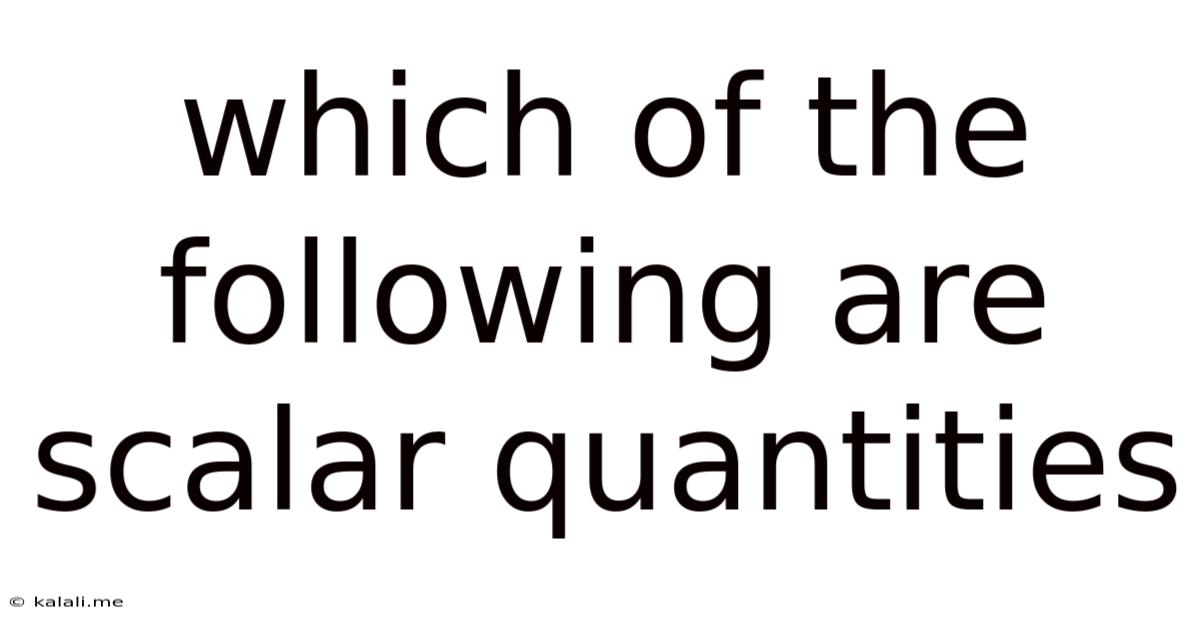Which Of The Following Are Scalar Quantities
Kalali
Jun 11, 2025 · 3 min read

Table of Contents
Which of the Following are Scalar Quantities? A Comprehensive Guide
Meta Description: Understanding scalar quantities is crucial in physics and various fields. This guide clarifies the definition of scalar quantities, provides examples, and helps you distinguish them from vector quantities. Learn how to identify scalars and master this fundamental concept.
Scalar quantities are physical quantities that are fully described by a single numerical value (magnitude) with a corresponding unit. Unlike vector quantities, which require both magnitude and direction, scalars only possess magnitude. This seemingly simple distinction is fundamental to understanding many physical phenomena. This article will explore scalar quantities, provide clear examples, and help you differentiate them from their vector counterparts.
What is a Scalar Quantity?
A scalar quantity is a measurement that only has a magnitude—a numerical value. It doesn't have a direction associated with it. Think of it as a single number representing a specific physical property. For instance, the mass of an object is a scalar; it's just a number indicating how much matter the object contains, regardless of where it's located or how it's moving.
Here's a breakdown of key characteristics:
- Only Magnitude: Scalars are solely defined by their numerical value.
- No Direction: They lack any directional component.
- Simple Arithmetic: Standard arithmetic operations (addition, subtraction, multiplication, and division) can be directly applied to scalars.
Examples of Scalar Quantities
Let's delve into some common examples to solidify your understanding:
- Mass: The amount of matter in an object (kilograms, grams).
- Temperature: The degree of hotness or coldness (Celsius, Fahrenheit, Kelvin).
- Time: Duration or interval (seconds, minutes, hours).
- Speed: The rate at which an object covers distance (meters per second, kilometers per hour). Note the distinction between speed (scalar) and velocity (vector).
- Energy: The capacity to do work (Joules).
- Work: The product of force and displacement (Joules).
- Power: The rate at which work is done (Watts).
- Density: Mass per unit volume (kilograms per cubic meter).
- Volume: The amount of space occupied by an object (cubic meters, liters).
- Length: The distance between two points (meters, centimeters).
- Frequency: The number of occurrences of a repeating event per unit time (Hertz).
- Electric Charge: The fundamental property of matter that experiences a force in an electromagnetic field (Coulombs).
Differentiating Scalars from Vectors
The key difference between scalars and vectors lies in the presence or absence of direction. While scalars only have magnitude, vectors possess both magnitude and direction. For example, velocity is a vector because it specifies both the speed (magnitude) and the direction of motion. Force is another example; it's not enough to know the strength of a force; its direction is equally important.
This distinction is crucial in physics and engineering calculations. Vector addition and subtraction require considering both magnitude and direction, while scalar operations are simpler.
Identifying Scalar Quantities in Problems
When faced with a problem involving physical quantities, ask yourself: Does this quantity have a direction associated with it? If the answer is no, it's likely a scalar quantity. Consider the units; if the units don't imply a direction (e.g., meters/second for speed vs. meters/second east for velocity), it's a good indicator of a scalar.
Conclusion
Understanding the difference between scalar and vector quantities is fundamental to grasping many concepts in physics and related fields. By focusing on the presence or absence of direction and carefully considering the units involved, you can confidently identify scalar quantities in various problems and calculations. Remember, this distinction is crucial for accurate and meaningful analysis of physical phenomena.
Latest Posts
Latest Posts
-
How Many Pounds Is A Bushel Of Peanuts
Jul 01, 2025
-
How Many Pounds Are In 32 Ounces
Jul 01, 2025
-
What Year Would I Be Born If I Was 21
Jul 01, 2025
-
How Many Minutes Are In 40 Hours
Jul 01, 2025
-
How Many Cups Are In 16 Oz Of Sour Cream
Jul 01, 2025
Related Post
Thank you for visiting our website which covers about Which Of The Following Are Scalar Quantities . We hope the information provided has been useful to you. Feel free to contact us if you have any questions or need further assistance. See you next time and don't miss to bookmark.